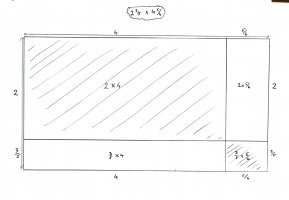Well, you can
show them that the result is wrong, on a calculator (using decimals)!
Or, you can explain that they are claiming that [math]\left(2+\frac{3}{5}\right) \times \left(4+\frac{5}{6}\right)=2\times4+\frac{3}{5}\times\frac{5}{6}.[/math] If they happen to have seen the distributive property, they would know that's wrong; if not, you can show that other examples don't work, such as [math](1+2)\times(3+4)\ne1\times3+2\times4.[/math]
This shows
why what they did doesn't work. And then you might carry out the distribution for each example to show what is missing. (This also shows why using improper fractions is more efficient, though not the only correct method.)
ADDENDUM: If they don't believe in calculators, or want something related to what they've learned about multiplication, you could use an area model, making a rectangle 2 3/5 by 4 5/6 and seeing that the area is bigger than 9. Or use a simpler example, like 3 1/2 by 4 1/5, and actually count up the total area, which illustrates the distributive property. For a demonstration of these ideas, see
here (in the last half of the page).

